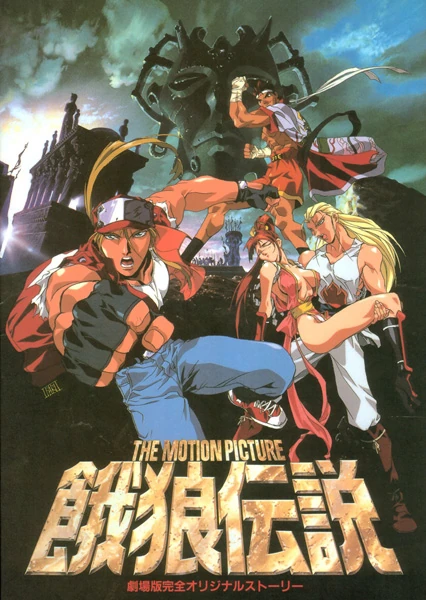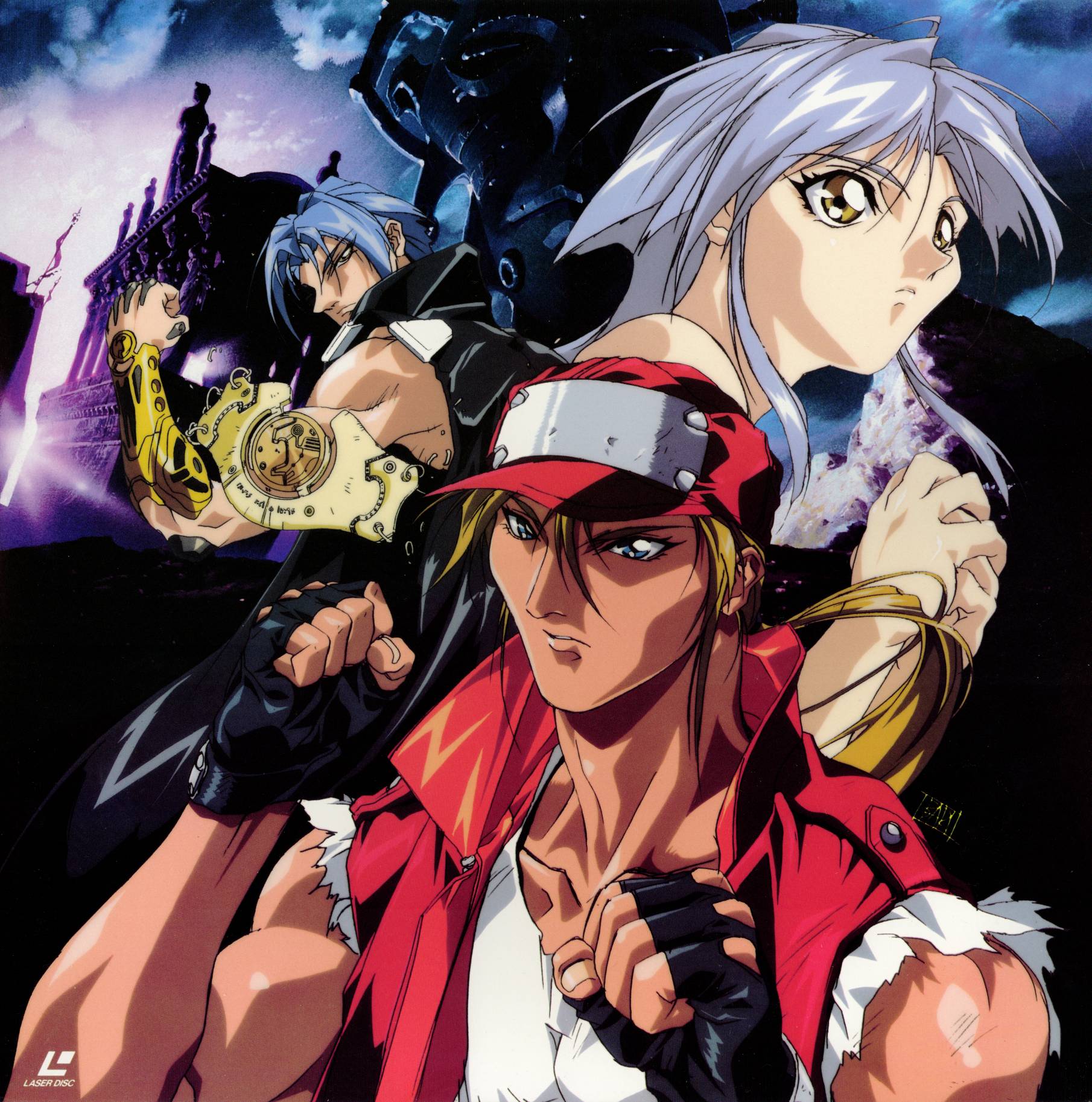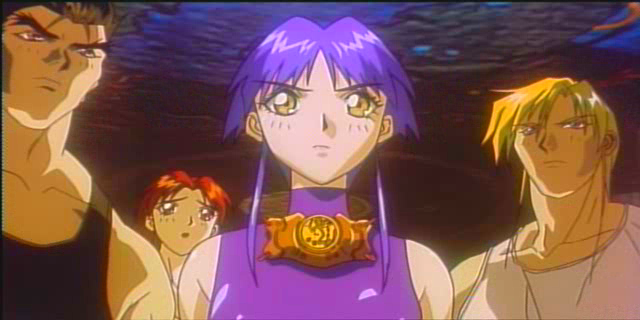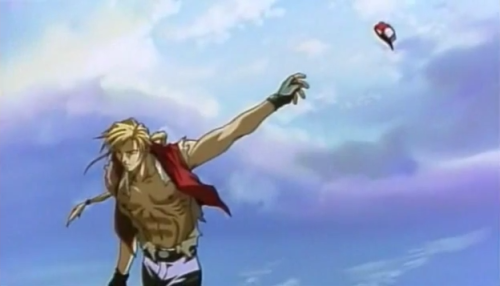Anime Review: Fatal Fury – The Motion Picture
This was written for Eat Your Serial/Maglomaniac on June 24th 2013

With my love for SFII: The Animated Movie pronounced greatly
as per my earlier bullpen bulletin, I bet you were wondering where I went from
there. As I was riding high after
watching SFII and preserving it for posterity at the time, I came across a
commercial about anime movies, made for TV, being shown on the Sci-Fi channel
(years before it became SyFy). As I
watched the clips, I came across a certain figure. I saw a red cap-wearing blond in a
sleeveless t-shirt, torn blue jeans, a red jacket, and red Converse
sneakers. He raised his fist up, drove
it into the ground and yelled out a phrase almost as iconic as, “Hadoken!” The phrase was “Power Wave!” The intention of this commercial was
clear. If you liked SFII, look what else
was on the horizon: another fighting game translated to anime on cable
television. The name of the game series:
Fatal Fury. The movie on deck: Fatal Fury
– the motion picture. The review: right
here and right now.
Fatal Fury is a fighting game series that was created by
Takashi Nishiyama and Hiroshi Matsumoto, the original planners of Street
Fighter before departing for SNK. Fatal
Fury was to be a more technically sound fighting game focusing on counters and
precision strikes, not so much on combos.
This was in stark contrast to what Street Fighter became, and of course,
comparisons were drawn. Fatal Fury
maintained more than a handful of sequels in the series that, unfortunately, started
to wane very early on. The series would
receive resurgence with its final game: Fatal Fury – Mark of the Wolves, which
stands as arguably the best title in the series. The game was more of SNK’s way of attempting
a new game play system reminiscent to Street Fighter Alpha and Street Fighter 3,
using more in-depth animated sprites and a newer generation of fighters. And, that’s a brief synopsis of the
series. So, how and where does the anime
fit in?


Fatal Fury had three animated movies adapted from the series
itself. The first movie was based on the
first game and the second was based on the sequel. The movie I saw was actually the third movie
which came out before the King of Fighters game and even the third Fatal Fury
game. So, it’s a completely different
story with no connection to the games, save for cameos and such. The first two movies were animated specials
as opposed to this, which was an actual feature film. The story covers the legendary artifact known
as “The Armor of Mars”. The armor was
imbued with the power of Mars, the god of war.
It was initially utilized by Gaudemus, a tyrannical despot who used this
power to take over various parts of the Middle East, like Alexander the
Great. This armor makes for a great
archaeological find as Cheng Sinzan had come across one piece. The only problem was others were looking for
it, too. These other people are the
antagonists of the film, with powers connected to the elements of earth. Their leader, Laocorn had come across the
first two pieces of the armor and wastes no time taking the third from
Cheng. As his search continues, the only
chance to stop him lies with his twin sister, Sulia. Sulia finds Terry Bogard in Japan who
initially was in town to see Joe Higashi’s kickboxing fight along with his
brother Andy, and Andy’s girlfriend, Mai Shiranui. Once they all meet, we get a cross-country
race to obtain all the pieces before the unthinkable occurs: the potential
return of Mars and the world’s destruction.


While the movie makes a concentrated effort to tell a solid
stand-alone story involving those in the Fatal Fury universe, I found this
movie in comparison to Street Fighter to be, well, not as solid. The big selling point of the film is Terry’s
falling for Sulia in hopes to protect her from death, as he failed to do with
his first love interest. This never
happened in the game, sure, but it really takes away from Terry’s bravado,
making him seem wimpier in some cases. There’s
also a lot of humor to a very raunchy degree.
In fact, this movie is best seen on DVD or VHS, as it was heavily
censored on Sci-Fi when I saw it. That
could be the fault of Sci-Fi trying its best to keep it clean or the fault of
the director who makes it a point to allow for more raunchy material in his
work. If you want a full analysis on the
director, watch the review of this movie done by Bennett the Sage on Anime
Abandon. My biggest problem with the
film was the pacing in a sense. There
was a lot of time between battles to ex-posit story. It can wear on you if you’re looking for some
battles. In fact, compared to the first
two features, this probably has the least amount of fighting in it. This makes sense as it is more of an
adventure and not a tournament. However,
if this is your first film of the three to watch, you may be disappointed
seeing your favorite characters look pale in comparison to the villains in the
film, knowing that your favorites are much stronger than that. I also wasn’t high on how the characters were
drawn as they all looked very lean and not too muscular. Other than that, it was an interesting
approach to the story of Fatal Fury.
Just don’t expect it to be as dynamic as that of Street Fighter.


It seems that Fatal Fury and Street Fighter not only differ
in game mechanics. They also differ in
motion picture motifs. While Street
Fighter II based itself on the actual tournament, giving more depth and story
to the characters themselves, Fatal Fury took a different turn by telling a new
story unrelated to the series itself.
The action seems a bit lop-sided, coercing you to watch the initial two
films if you want to see how the protagonists handle themselves in battle. The drama does leave a bit to be desired, as
the mood shifts around a bit and the pacing may seem a bit off. Still, it makes for a different approach to a
movie about a fighting game as it has a whole new story. So where does this lie? Just like Terry Bogard’s catchphrase, it’s
“OK!”

Comments
Post a Comment